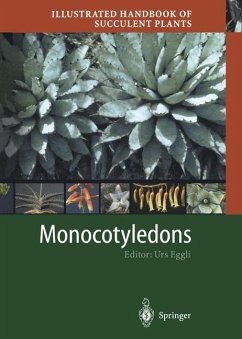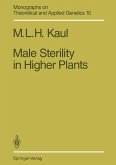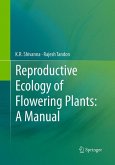Handbooks devoted to succulent plants (including cacti) have a long-standing tradition, and the demand for updated editions is a good indication of the high degree of interest that exists in this fascinating group of plants. While first handbooks devoted to the family Cactaceae were already published in the 19th cen tury, the first handbook dealing with the so-called 'other' succulents was authored by Hermann Jacobsen and published in 1954 -1955, then called "Handbuch der sukkulenten Pflanzen". A re vised and enlarged English edition was made available in 1959 and was repeatedly reprinted in the following years. A major step towards a compact handbook including short descriptions, full synonymy and hundreds of illustrations was the publication of the first edition of Hermann Jacobsen's celebrated "Sukkulentenlexikon" in 1970, followed by the English edition in 1975, and a revised German ed ition in 1981, finished by Klaus Hesselbarth following Hermann Jacobsen's death in August 1978. The demand for updated compact information on succulent plants has not diminished since then, and contrary to Hermann Jacobsen's opinion (preface to the German edition 1970) that the number of papers dealing with succulent plants was on the decline, the interest in succulent plants was growing, both among hobbyists and among botanists. The results are numerous new taxa in many families, and many monographs of previously little-known groups have been published in the last 30 years. Accordingly, a need for a "New Lexicon" was beginning to be felt, both for 'other' succulents and for cacti.
From the reviews of the first edition:
"This series is a reference manual for taxonomists and horticultural cognoscenti. It compiles up-to-date information not readily available from other sources ... . This series is invaluable to identify succulents, by either picture keying ... or by formal text keying. ... The volumes are well produced. ... this is an excellent series, a significant contribution to the literature, and a superb production. ... This fine series is a boon to all aficionados of succulents ... ." (Rudolf Schmid, Taxon, Vol. 52, 2003)
"This 'Illustrated Handbook of Succulent Plants' ... presents the newest stand of knowledge in all aspects of this group of plants. ... the cross reference index is very helpful. ... this comprehensive taxonomic work updating the increased knowledge of succulents in 20 years is well suited and highly recommended to all plant scientists, including herbarium staff, and horticulturists, and to the wide range of fascinated hobbyists. ... this volume will find a very wide readership ... ." (Norbert Leist, Journal of Plant Physiology, Vol. 159 (7), 2002)
"Here is the first volume of the new Illustrated Handbook of Succulent Plants ... . My first impression with the book in my hand was of pleasure. It is very well produced, accurately bound, with an excellent cover design. ... No doubt that such a work is particularly useful to the botanist and the scholar, as well as to the serious collector. But I have no hesitation to state that any succulent plant lover should find a place for it in his library ... ." (L. Russo, Botanybooks, September, 2001)
"We are promised a total of six volumes on ... succulents under the title of the Illustrated Handbook of Succulent Plants. ... The first of these volumes to appear is the one on monocotyledons. ... this is an excellent introduction to the plant groups covered and as a rigorous compilation of both diagnostic and bibliographic information iswithout peers. ... It is essential for the committed collector of succulent plants and mandatory for libraries of plant societies, herbaria and botanic gardens." (Paul I. Forster, Plant Systematics and Evolution, Vol. 229 (1-2), 2001)
"This series is a reference manual for taxonomists and horticultural cognoscenti. It compiles up-to-date information not readily available from other sources ... . This series is invaluable to identify succulents, by either picture keying ... or by formal text keying. ... The volumes are well produced. ... this is an excellent series, a significant contribution to the literature, and a superb production. ... This fine series is a boon to all aficionados of succulents ... ." (Rudolf Schmid, Taxon, Vol. 52, 2003)
"This 'Illustrated Handbook of Succulent Plants' ... presents the newest stand of knowledge in all aspects of this group of plants. ... the cross reference index is very helpful. ... this comprehensive taxonomic work updating the increased knowledge of succulents in 20 years is well suited and highly recommended to all plant scientists, including herbarium staff, and horticulturists, and to the wide range of fascinated hobbyists. ... this volume will find a very wide readership ... ." (Norbert Leist, Journal of Plant Physiology, Vol. 159 (7), 2002)
"Here is the first volume of the new Illustrated Handbook of Succulent Plants ... . My first impression with the book in my hand was of pleasure. It is very well produced, accurately bound, with an excellent cover design. ... No doubt that such a work is particularly useful to the botanist and the scholar, as well as to the serious collector. But I have no hesitation to state that any succulent plant lover should find a place for it in his library ... ." (L. Russo, Botanybooks, September, 2001)
"We are promised a total of six volumes on ... succulents under the title of the Illustrated Handbook of Succulent Plants. ... The first of these volumes to appear is the one on monocotyledons. ... this is an excellent introduction to the plant groups covered and as a rigorous compilation of both diagnostic and bibliographic information iswithout peers. ... It is essential for the committed collector of succulent plants and mandatory for libraries of plant societies, herbaria and botanic gardens." (Paul I. Forster, Plant Systematics and Evolution, Vol. 229 (1-2), 2001)








